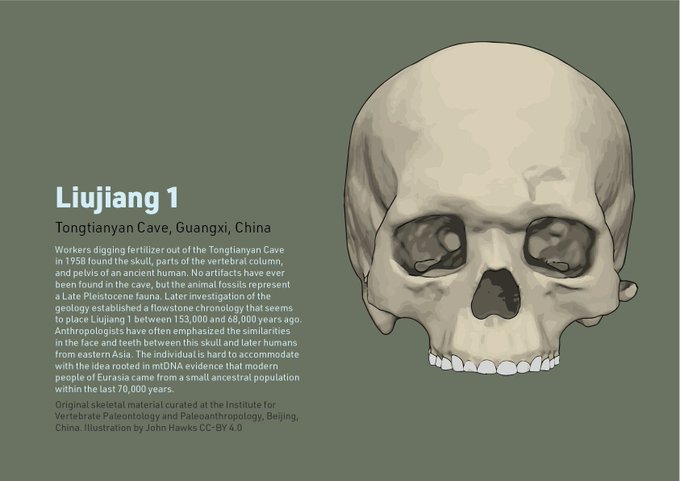paleoanthropologyのTwitterイラスト検索結果。 121 件中 5ページ目
On #DarwinDay, I want to recognize the Gibraltar 1 Neandertal skull. This year marks 150 since the publication of The Descent of Man, and this skull was the only skeletal evidence of an extinct human ancestor that Charles Darwin encountered. #paleoanthropology #FossilFriday
The "robust" #hominin lineage shows some differences between earlier and later P. boisei fossils from the East African Rift Valley. Omo 57-41 at 2.36 million years old is near the critical transition time. Maybe it's P. aethiopicus, or maybe not? #paleoanthropology
Fossil #hominin remains are often distorted when we find them, by natural weathering, moisture, or the weight of sediments that build above them. Sterkfontein, South Africa, has a complex array of depositional environments that left their mark on the fossils. #paleoanthropology
Pleistocene humans had bodies within the same range of sizes as living people. This hip bone from Arago, France, came from an individual of around 80 kg, not far from the weight of French men today. #hominin #paleoanthropology
Mary Leakey's team excavated the OH 13 partial skull in 1962. More recent work at the site has placed this #hominin skull as the last known appearance of Homo habilis. The species earliest appearance at Olduvai is only around 180,000 years earlier. #paleoanthropology
LES1 is the most complete known for Homo naledi so far. Its morphology holds clues about the life of this #hominin individual that we are still working to understand. #paleoanthropology #FossilFriday
The AL 333 locality at Hadar is a striking assemblage of at least 13 #hominin individuals attributed to Australopithecus afarensis, including at least 4 children. How these individuals came to rest together is still not known, taphonomy rules out a flash flood. #paleoanthropology
The fossil hominins from Zhoukoudian, China, are among the best known Homo erectus samples. Approximately the same age as fossils from Spain attributed to H. antecessor, the connection between these #hominin populations is currently unknown. #paleoanthropology
The Krapina 58 mandible has a rotated left premolar, a trait found in a curiously high fraction of this large Neandertal sample. It may reflect the genetics of this local population #hominin #paleoanthropology
Paranthropus boisei is one of the best-known fossil #hominin species. Part of a branch that existed for more than 1.5 million years, adults could generate incredible bite force--shown by the huge area for the temporalis muscle. #paleoanthropology #FossilFriday
Ralph von Koenigswald took pains to hide fossil #hominin remains during World War II, but the Japanese occupation army selected Ngandong 10 "as a birthday present for the Japanese emperor and kept in the Imperial palace of Kyoto" (as recounted by Teuku Jacob) #paleoanthropology
Few fossil #hominin samples preserve evidence of the postcranial skeleton in abundance, but Homo naledi from the Dinaledi Chamber is one of them. These fossils are only around 250,000 years old, but the scapula resembles some of the earliest known hominins. #paleoanthropology
One of the branches of the #hominin tree can be traced today as far as 4.1 million years ago, at Kanapoi, Kenya. Here, the track becomes unclear. What was the origin of the Australopithecus line, and how does it connect to fossils like Ardipithecus? #paleoanthropology
For more than 100 years, the remains of a Neandertal child lay unrecognized in Belgium after being unearthed in 1829. Much of the child's context was lost in excavation, but today Engis 2 is crucial evidence about growth and development in #paleoanthropology #hominin
When I turned to #paleoanthropology, I knew that teeth made up a disproportionate amount of the record, but I couldn't imagine I would ever be very interested. What fascinates me now are the clues they give about an individual #hominin's life course.
Paranthropus aethiopicus is one of the fossil #hominin species that may be a "nomen dubium". The holotype specimen is Omo 18-18, a jaw that lacks any tooth crowns. What remains isn't distinct from large samples of P. boisei or P. robustus. #paleoanthropology
Quite a lot of evidence now suggests ancient people usually classified as "modern" humans were in China before 68,000 years ago. None are as telling as the Liujiang individual, which shows anatomical similarities with more recent people of the area. #paleoanthropology #hominin
The perils of understanding extinct populations with morphology are front and center with the Arago #hominin sample. Were they early Neandertals, or something else? My guess is a mosaic of drift in ancient Eurasian populations. #paleoanthropology
Some parts of the skeleton are very rare in the #hominin fossil record. The hand remains of Homo naledi, including this articulated specimen, tell us much about the tool-using potential of this species, while suggesting it was a great climber. #paleoanthropology
Some fossil #hominin skulls have an important place in understanding the variation of extinct species. Stw 505 is a large Australopithecus africanus skull, helping to show that big individuals had brains that overlapped in size with the larger-brained Homo. #paleoanthropology




















